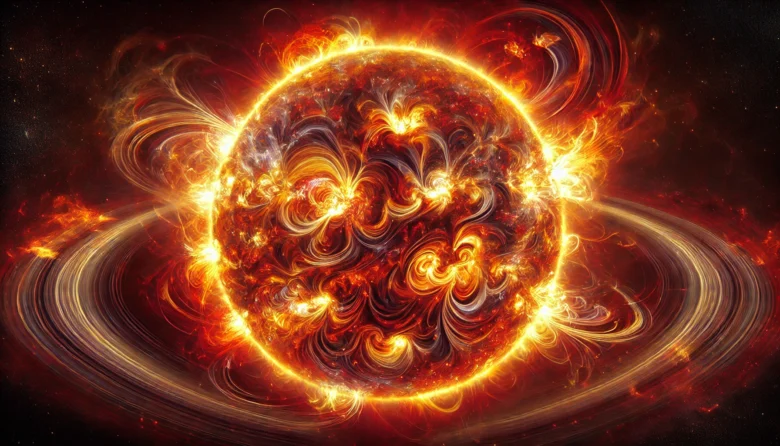When we think of matter, the first things that come to mind are solids, liquids, and gases—the three familiar states we encounter daily. But there’s a lesser-known state that’s just as fascinating and far more prevalent in the universe: plasma, the fourth state of matter. From the sun’s blazing core to the glow of neon signs, plasma plays a crucial role in the cosmos and our daily lives. In this blog, we’ll explore what plasma is, where it’s found, and why it’s so important in the world of physics.
Introduction
So, what exactly is plasma? Plasma is commonly referred to as an “ionized gas,” but that simple description doesn’t quite capture the complexity and significance of this state of matter. Plasma forms when a gas is heated to extremely high temperatures, causing the atoms to lose electrons and creating a mixture of charged particles: positively charged ions and negatively charged electrons. This unique composition gives plasma properties that are distinct from solids, liquids, and gases. In this blog, we’ll delve into the physics of plasma, explore its various applications, and understand why it’s called the “fourth state of matter.”
What Makes Plasma Different?
Understanding plasma helps compare it to other states of matter. In a solid, the atoms or molecules are closely packed and vibrate in place, giving the material a definite shape. In a liquid, the particles are still close but can move around each other, allowing the liquid to flow. In a gas, the particles are far apart and move freely, filling any container they’re in.
Plasma, however, is a different beast altogether. When a gas is heated to extremely high temperatures—thousands or even millions of degrees Celsius—it becomes so energetic that electrons are stripped away from atoms. This process results in a mixture of free electrons and ions, which gives plasma its distinct characteristics. Unlike gases, plasmas conduct electricity, generate magnetic fields, and respond strongly to electromagnetic forces.
Where Do We Find Plasma?
You might be surprised to learn that plasma is the most common state of matter in the universe. In fact, 99% of the visible universe is in the plasma state! Here are some places where plasma can be found:
The Sun and Stars: The sun is a gigantic ball of plasma where nuclear fusion occurs, producing light and heat that sustains life on Earth. All stars are essentially massive plasma reactors.

Lightning: When lightning strikes, the air becomes superheated and ionized, creating a temporary plasma. This is why lightning emits light and heat.
Neon Signs: The glowing tubes of neon signs are filled with gas, typically neon, that is turned into plasma by an electric current, producing that familiar bright glow.
Auroras: The stunning auroras seen near the poles are caused by solar winds—streams of plasma from the sun—interacting with Earth’s magnetic field.
Plasma TVs: Although now largely replaced by newer technologies, plasma televisions use tiny cells of plasma to create images on the screen.
The Physics Behind Plasma
Plasma’s unique properties arise from its composition of charged particles. These particles allow plasma to conduct electricity and generate magnetic fields, making it highly responsive to electromagnetic forces. Here’s a closer look at some of the key physics principles related to plasma:
Electromagnetic Fields: Since plasma consists of charged particles, it generates its own magnetic fields and can be affected by external magnetic forces. This property is used in devices like magnetic confinement fusion reactors, which attempt to contain plasma using powerful magnets.
Plasma Oscillations: The electrons in a plasma can oscillate in response to disturbances, creating waves that propagate through the plasma. These oscillations are a fundamental aspect of plasma physics and are studied to understand phenomena like solar flares.
Temperature and Ionization: The temperature of a plasma is crucial in determining its degree of ionization. For instance, the core of the sun reaches about 15 million degrees Celsius, which is hot enough to maintain nuclear fusion and sustain the sun’s plasma state.
Case Study: Plasma in Fusion Energy
One of the most exciting applications of plasma physics is in the field of nuclear fusion. Fusion is the process that powers the sun, where atomic nuclei combine at high temperatures to release energy. For decades, scientists have been striving to harness fusion as an energy source on Earth, with plasma playing a central role in this endeavour.
In fusion reactors like the International Thermonuclear Experimental Reactor (ITER) in France, plasma is heated to millions of degrees Celsius and confined using powerful magnetic fields. The goal is to sustain the plasma long enough for fusion to occur, releasing massive amounts of energy. If successful, fusion could provide a nearly limitless and clean source of energy, revolutionizing how we power our world.
Everyday Applications of Plasma
While plasma fusion reactors are still in development, plasma is already used in many everyday applications:
Plasma Cutting: In industrial settings, plasma cutters are used to slice through metal with incredible precision. The cutter creates a high-temperature plasma arc that melts the metal, allowing it to be cut cleanly.
Sterilization: Plasma is also used in medical and dental fields for sterilization. Plasma sterilizers create reactive ions that kill bacteria and viruses, making instruments safe for use.
Plasma Etching: In electronics manufacturing, plasma etching is a process used to remove material from a surface with precision, crucial in the production of microchips.
Space Propulsion: Plasma thrusters are being developed for spacecraft propulsion, offering a more efficient alternative to chemical rockets for long-duration space missions.
The Challenges of Working with Plasma
Despite its many uses, working with plasma presents significant challenges. Because plasma requires very high temperatures, containing it without damaging the surrounding materials is difficult. In fusion reactors, for instance, plasma needs to be confined within a magnetic field to prevent contact with the reactor walls, which could cause damage or even failure.
Additionally, controlling plasma behaviour is complex due to its responsiveness to electromagnetic fields. Small disturbances can lead to instabilities, making it difficult to maintain the conditions necessary for certain applications, like sustained nuclear fusion.
The Future of Plasma Physics
The study of plasma physics is a vibrant field with numerous exciting developments on the horizon. As researchers continue to explore the complexities of plasma, it is likely that new applications and technologies will develop. The potential for clean energy through fusion, advancements in space travel, and innovations in manufacturing and medicine all point to a future where plasma plays an even more central role in our lives.
Conclusion
Plasma may not be as familiar as solids, liquids, or gases, but it is by far the most prevalent state of matter in the universe and one of the most important to study. From the power of the sun to the cutting-edge technology in our labs, plasma touches nearly every aspect of our lives, often in ways we don’t even realize.
As our understanding of plasma physics deepens, so too will our ability to harness this remarkable state of matter for the benefit of humanity. Whether it’s through clean energy, advanced manufacturing, or exploring the far reaches of space, plasma holds the key to many future advancements. So next time you see a neon sign or watch a lightning storm, remember—you’re witnessing the fourth state of matter in action.
Author’s Note:
Exploring the world of plasma opens up a universe of possibilities, both literally and figuratively. I hope this blog has demystified the physics of plasma and sparked your curiosity about the countless ways this fascinating state of matter influences our world and beyond.
G.C., Ecosociosphere contributor.





Comments
I do agree with all the ideas you have introduced on your post They are very convincing and will definitely work Still the posts are very short for newbies May just you please prolong them a little from subsequent time Thank you for the post
Hi Neat post There is a problem along with your website in internet explorer would test this IE still is the market chief and a good section of other folks will pass over your magnificent writing due to this problem